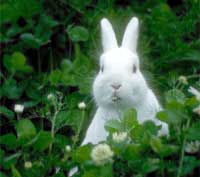How to prowl for wild animals?

Photo: LiveScience
If you want to catch a certain animal, perhaps you should slowly pedal rather than tiptoe. It was a trick that the young daughter of psychologist Niko Troje had done, when she was trying to catch wild rabbits near her home. But neither the girl nor Troje understood why the bike was less active for rabbits.
In a new study, Troje and his colleagues at Queen's University learned how humans discovered and deciphered movements, thus deducing the animal.
They recorded cats, doves, and people, focusing on some movements. When watching the tape digitized, people can easily recognize the size of the animal and its direction.
Things become more difficult when images are reversed and people cannot recognize left and right based on movement. It seems that humans, like many other animals, are trained to decode foot movements in a certain way.
" We believe that this image selection is applied to recognize the appearance of animals, based on foot movement and gravity ," Troje said.
Scientists believe that the mechanism for detecting this movement is part of a long-term evolutionary system that helps animals quickly detect nearby enemies or prey. Other studies show that even a newly hatched chicken uses this detection system. It seems that the brain has been programmed for that type of identification.
Some predators, such as cats and cows, crawl to deceive foot movement, helping them to hunt better. The study also explains the instinctive fear of snakes, insects, spiders . - species that do not have the type of movement that match the normal detection mechanism.
MT
- Photography: 'Talking eyes' of wild animals
- American wild boar 'invades' Mexico
- 7 differences between animals and wild animals
- Why did Australia destroy 2 million cats?
- Fascinating wild dogs with lovely looks, personality like wolves
- Strange tragedy of children living with wild animals
- DNA testing for wild dogs suddenly discovered the rare animals on the planet
- Mysterious children are raised by wild animals
- See pictures of migrant animals
- 7 species of wild animals are being eradicated by humans
- Kangaroo roars with wild dogs
- Wild tours are causing serious consequences
 Animal 'suffering' after hibernation
Animal 'suffering' after hibernation Why do goats climb well?
Why do goats climb well? Scientists were surprised to see chimpanzees eating turtles
Scientists were surprised to see chimpanzees eating turtles Giant catfish died deadly due to drought in Thailand
Giant catfish died deadly due to drought in Thailand